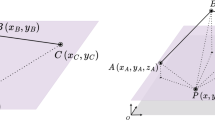Abstract
Acontext is defined to be a triple (G, M, J) of setsG, M and an incidence relationJ ⊂ G×M.
A finite set ℒ ofn oriented lines in general position in the euclidean plane induces a cell decomposition of the plane. For a givenk-element subset ℐ of cells of dimension 2, we define an incidence relationJ ⊂ ℐ × ℒ as follows:t i andl j are incident if and only ift i lies on the positive side with respect tol j .
We call a context (G, M, J)represented in a line arrangement if and only if there are relation preserving bijections betweenG and ℐ,M and ℒ, respectively. We study conditions for a context to be representable in a line arrangement.
Especially, we provide a non-trivial infinite class of contexts which can not be represented in a line arrangement.
Similar content being viewed by others
References
Bokowski, J. and Sturmfels, B. (1989) Computational synthetic geometry,Springer Lecture Notes 1355.
Bokowski, J. and Richter, J. (1990) On the classification of non-realizable oriented matroids, part I, generation. Manuscript, 17pp.
CordovilR. (1982) Sur les matroïdes orientés de rang 3 et les arrangements de pseudodroites dans le plan projectif réel,European J. Combinatorics 3, 307–318.
Feger, H. (1989) Testdaten als Merkmalsvektoren, Beitrag zur Festschrift für Karl Josef Klauer,Wissenschaft und Verantwortung.
FolkmanJ. and LawrenceJ. (1978) Oriented matroids,J. Combinatorial Theory B25, 199–236.
Ganter, B. and Wille, R. (1992) Formale Begriffsanalyse, Manuscript 75pp., BI Verlag.
GoodmanJ. E. and PollackR. (1980) Proof of Grünbaum's conjecture on the stretchability of certain arrangements of pseudolines,J. Combinatorial Theory, Ser. A29, 385–390.
Grünbaum, B. (1972) Arrangements and spreads.American Math. Soc., Regional Conf. Ser. 10.
Kollewe, W. (1992) Graphische Darstellungen von Kontexten als Geradenarrangement, Diplomarbeit, TH Darmstadt.
Las VergnasM. (1975) Matroïdes orientables, preprint, 80 pages, announced inC. R. Acad. Sci. Paris, Ser. A280, 61–64.
Las Vergnas, M. (1978) Extensions ponctuelles d'une géométrie combinatoire, inProblémes combinatoires et théorie des graphes (Actes Coll. Orsay 1976), C.N.R.S., pp. 265–270.
Las VergnasM. (1975) Matroides orientables,C. R. Acad. Sci. Paris 280, 61–64.
Richter, J. (1989) Kombinatorische Realisierbarkeitskriterien für orientierte Matroide,Mitteilungen aus dem Mathem. Seminar Giessen, Heft194, 112pp.
RingelG. (1956) Teilungen der Ebene durch Geraden oder topologische Geraden,Math. Zeitschrift 64, 79–102.
Roudneff, J.-P. (1987) Matroides orientes et arrangements de pseudo-droites. Thèse, Paris.
Wille, R. (1989) Geometric representation of concept lattices, Preprint 1225, TH Darmstadt.
Author information
Authors and Affiliations
Additional information
Communicated by R. Wille
Rights and permissions
About this article
Cite this article
Bokowski, J., Kollewe, W. On representing contexts in line arrangements. Order 8, 393–403 (1991). https://doi.org/10.1007/BF00571189
Received:
Accepted:
Issue Date:
DOI: https://doi.org/10.1007/BF00571189



